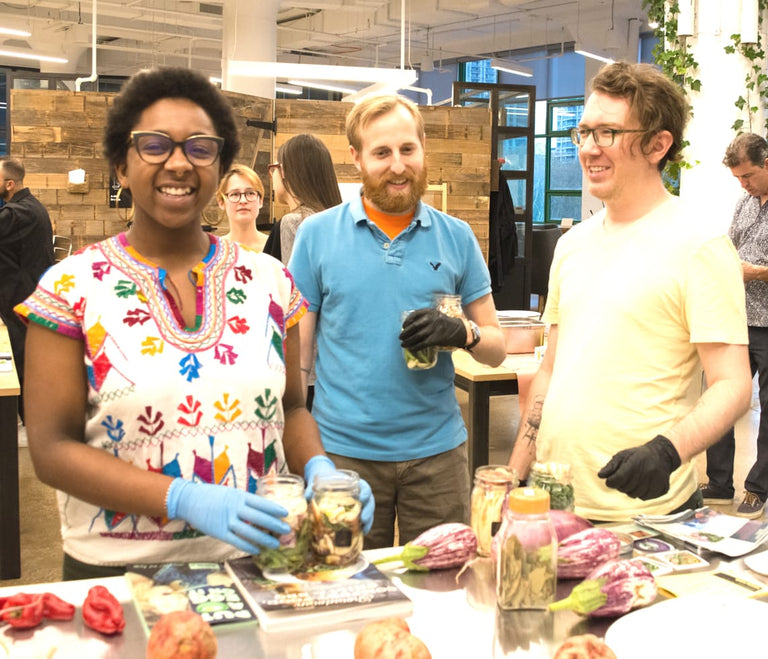Soil Health Impacts Flavor and Nutrition

Have you ever described a beet’s flavor as “earthy”? Perhaps you’ve taken a bite of a carrot and felt like you could taste the soil? That isn’t a figure of your imagination or trick on your tastebuds. It’s true – sometimes, you can really “taste” the earth. The nutrients in the soil unsurprisingly affect the nutrient levels of the vegetables they produce, which actually has great impacts on their flavor.
“Terroir” is a term used by folks in the food industry to describe when growing conditions of a certain region seep into the taste or flavor of the products grown there. This kind of narrative is often used when talking about grapes in wines or San Marzano tomatoes, but how about the rest of the produce on our plates? Studies have found that not only where your food grows, but also the type of soil it grows in can greatly impact the health and taste of the food it produces.
When plants grow, they rely on a number of nutrients from the soil to feed and work in tandem with the vegetables life-cycle to produce delicious, robust, quality produce. It is a delicate balance of give and take. Some essential nutrients include carbon, hydrogen, nitrogen phosphorus and potassium. It takes years of healthy harvests, farming and compost cycles to develop the most productive soil make-up.

Modern farming practices have greatly impacted the health of the soil our food grows in, with long term land effects, in addition to growth consequences. About 95% of the world’s food grows on the uppermost layer of soil, otherwise known as topsoil. Through modern farming methods and practices, the world’s nutrient rich top-soil is disappearing. Already, nearly 50% of America’s topsoil has eroded as a result of the increased use of fertilizers, pesticides, aggressive plowing, and tilling practices, all in an attempt to increase growth rates, yield and create longer-lasting produce.
Industrial-scale farming has impacted nutrient levels in vegetables for the last century. From the 1930s, agricultural foundations, journals and academics conducted long term studies to better understand the changing nutritional values of our fruits and vegetables. Several studies found drops in the average level of calcium, iron, vitamin A and C and potassium in the plants. In order to get the same nutrients from an orange that our grandparents ate, one study proposed we would have to eat eight of today’s oranges.
Despite the consequences and impacts of some modern farming, there are still many farmers who prioritize the earth and environment through regenerative agricultural practices. Regenerative agriculture focuses on bringing important nutrients back into the soil, mainly carbon, working to make farms carbon “sinks” versus sources.
Regenerative farming also prioritizes the health and maintenance of the top-soil. By reducing tillage, the process of turning over and breaking up the soil, farmers can build up the beneficial microbes and insects that form healthy soil biology. Soil farming is a more holistic approach to the land. It includes recycling top-soil, rotating crops and composting. These practices both improve farm yield, as well as fighting climate change in the long term.
Although experts say it could take up to 500 years for the topsoil to rebuild and to “reverse” the effects commercial farming has created, there are a few simple ways to spot nutrient rich produce and support the farmers practicing sustainable, flavor and health forward farming practices.
- Color - look for produce that has bright, bold colors. Studies have shown that vegetables with brighter hues are full of more nutrients and higher counts of “phytochemicals” (the healthy chemical compounds found in plants).
- Understand preparation - it’s best to purchase whole vegetables, this way, none of the nutrients has been lost in preparation. To get the most out of your vegetables, do some research and see if certain preparation can enhance the nutrients found in your veggies. For example, carrots and broccoli are more nutritious when steamed rather than eaten raw or boiled.
- Bigger isn’t always better - plants can only pass so much nutrients to fruits and vegetables. Buying bigger doesn’t always mean more nutrients, so we suggest opting for smaller, more concentrated nutrient-packed options.
- Local goods - as products travel across the state, and sometimes country, to reach grocery store shelves, their nutritional value is depleted. Opt for fruits and vegetables grown close to your home and in season.
Local Roots farmers value process and product, but above all, they respect the land. That’s why our partners, farmers and purveyors place an emphasis on the local environment, and many of our farmers practice traditional methods of farming and producing. Take our friends at Moxie Ridge Farm, who allow their goats to feed on local hay and grains, in a method of terroir farming to ensure local, nutrient rich and flavorful cheeses. Similarly, Chaseholm Farm, a dairy farm in Pine Plains NY, is committed to grass based production, a practice that works to actively create and maintain healthy soil that their cows can graze in. The cows and grass work together to regenerate the soil. The folks at MX Morningstar Farm are also a great example, they believe in a holistic and balanced farm to improve the flavor and growth of their food. Using sustainable farming practices to build the health of their land, thus building healthier vegetables. Plus, our vegetables, fruits and meats never travel more than 2-hours, ensuring their nutrient-dense, hyper-local flavor remains in-tact.
Article by Local Roots Content Volunteer Sylvie Florman
Rather have a taste first?
Local Roots Experiences are fun, pop-up events where we bring the farm to you!

Become a Harvest Club Pick Up Location
Are you a NY based cafe, bar, or neighborhood business? Become a Harvest Club pick up location and have community members come to your establishment each week to pick up their Local Roots harvest.
Top






